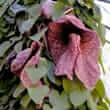Background
- Aristolochia spp. are found in diverse climates worldwide, but not in Australia. Because the aristolochic acid in Aristolochia spp. is known to cause kidney damage, the U.S. Food and Drug Administration (FDA) advises consumers to immediately discontinue use of any botanical products containing aristolochic acid. Currently, Britain's Committee on Safety of Medicines prohibits Aristolochia spp. in all unlicensed medicines, and it may only be obtained by prescription from a licensed doctor or dentist.
- In many areas, Aristolochia spp. are used in ethnomedicine for conditions such as cancer, wounds, and intestinal worms. Since the 1950s, some Aristolochia spp. have been used as substitutes in Chinese herbal medicine for certain Akebia spp., Saussurea (Auklandia) spp., Clematis spp., and Stephania tetrandra. In fact, when nine samples of fangji (Stephania tetrandra) were purchased from Hong Kong herbal shops and analyzed for aristolochic acids, all of the samples contained aristolochic acids. Stephania tetrandra does not contain aristolochic acids.
- During 1990-1992, a Belgium clinic prescribed a Chinese herbal weight-loss remedy that substituted Aristolochia fangchi for Stephania tetrandra. Many of the patients developed a progressive kidney disorder called aristolochic acid nephropathy. Doses higher than 200 grams were linked to a higher risk of urinary tract cancer.
- It is believed that the seeds of Aristolochia clematitis that have been accidentally harvested along with wheat from fields in Bosnia, Bulgaria, Croatia, Romania, and Serbia may be the cause of endemic (Balkan) nephropathy and a high rate of endemic kidney failure in certain areas.
References
Natural Standard developed the above evidence-based information based on a thorough systematic review of the available scientific articles. For comprehensive information about alternative and complementary therapies on the professional level, go to . Selected references are listed below.
- Balachandran, P, Wei, F, Lin, RC, et al. Structure activity relationships of aristolochic acid analogues: toxicity in cultured renal epithelial cells. Kidney Int 2005;67(5):1797-1805.
View Abstract - Camporese, A, Balick, MJ, Arvigo, R, et al. Screening of anti-bacterial activity of medicinal plants from Belize (Central America). J Ethnopharmacol 2003;87(1):103-107.
View Abstract - Capasso, A, Piacente, S, De Tommasi, N, et al. The effect of isoquinoline alkaloids on opiate withdrawal. Curr Med Chem 2006;13(7):807-812.
View Abstract - Chan, TY, Tam, HP, Lai, CK, et al. A multidisciplinary approach to the toxicologic problems associated with the use of herbal medicines. Ther Drug Monit 2005;27(1):53-57.
View Abstract - Hranjec, T, Kovac, A, Kos, J, et al. Endemic nephropathy: the case for chronic poisoning by aristolochia. Croat Med J 2005;46(1):116-125.
View Abstract - Laing, C, Hamour, S, Sheaff, M, et al. Chinese herbal uropathy and nephropathy. Lancet 7-22-2006;368(9532):338.
View Abstract - Lo, SH, Wong, KS, Arlt, VM, et al. Detection of Herba Aristolochia Mollissemae in a patient with unexplained nephropathy. Am J Kidney Dis 2005;45(2):407-410.
View Abstract - Meinl, W, Pabel, U, Osterloh-Quiroz, M, et al. Human sulphotransferases are involved in the activation of aristolochic acids and are expressed in renal target tissue. Int J Cancer 3-1-2006;118(5):1090-1097.
View Abstract - Mongelli, E, Pampuro, S, Coussio, J, et al. Cytotoxic and DNA interaction activities of extracts from medicinal plants used in Argentina. J Ethnopharmacol 2000;71(1-2):145-151.
View Abstract - Nok, AJ, Sallau, BA, Onyike, E, et al. Columbin inhibits cholesterol uptake in bloodstream forms of Trypanosoma brucei-A possible trypanocidal mechanism. J Enzyme Inhib Med Chem 2005;20(4):365-368.
View Abstract - Ruffa, MJ, Ferraro, G, Wagner, ML, et al. Cytotoxic effect of Argentine medicinal plant extracts on human hepatocellular carcinoma cell line. J Ethnopharmacol 2002;79(3):335-339.
View Abstract - Velazquez, E, Tournier, HA, Mordujovich, de Buschiazzo, Saavedra, G, et al. Antioxidant activity of Paraguayan plant extracts. Fitoterapia 2003;74(1-2):91-97.
View Abstract - Wu, TS, Leu, YL, and Chan, YY. Constituents from the stem and root of Aristolochia kaempferi. Biol Pharm Bull 2000;23(10):1216-1219.
View Abstract - Zhang, CY, Wang, X, Su, T, et al. New aristolochic acid, aristololactam and renal cytotoxic constituents from the stem and leaves of Aristolochia contorta. Pharmazie 2005;60(10):785-788.
View Abstract - Zhou, S, Koh, HL, Gao, Y, et al. Herbal bioactivation: the good, the bad and the ugly. Life Sci 1-9-2004;74(8):935-968.
View Abstract







